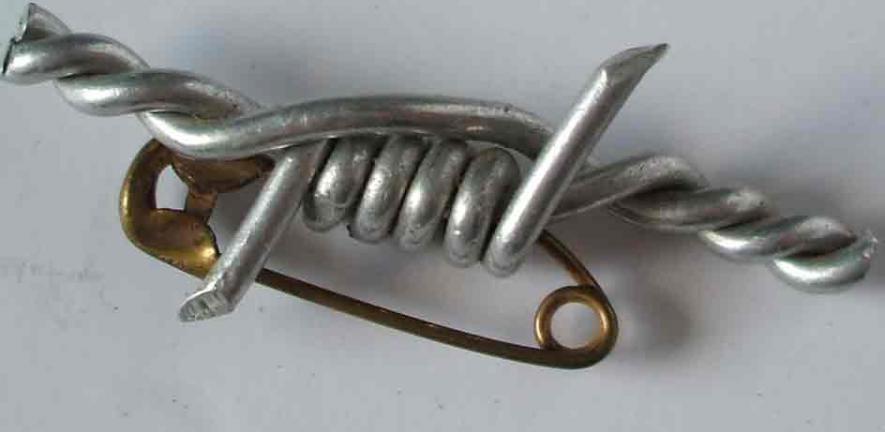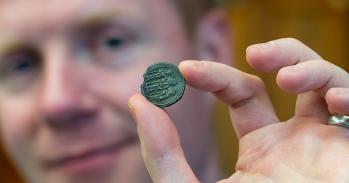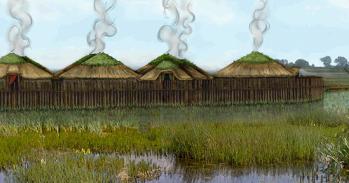
A fascinating study of wartime artefacts is uncovering a story of symbolic resistance and creative necessity in the Channel Islands 60 years ago.
A fascinating study of wartime artefacts is uncovering a story of symbolic resistance and creative necessity in the Channel Islands 60 years ago.
The Channel Islands, the only part of Britain that was occupied during WWII, endured a period of history that left such an impact on the collective psyche of its peoples that it forms an integral part of Channel Island identity and heritage today.
Often considered to be wartime kitsch, frequently ending up in junk shops or in rubbish skips, the artefacts made by people of the Channel Islands during World War II (WWII) have only recently been recognised as being worthy of academic enquiry. Like the ‘trench art’ created in the trenches of WWI, these artefacts were made from whatever supplies were at hand – coins, tin cans, spent shells, even barbed wire – in a time of military conflict and its legacy of deprivation and defiance. Thanks to funding from the British Academy, the artefacts held in Island museums and private collections are being catalogued and photographed by Dr Gilly Carr from the Department of Archaeology. They tell a story of the quiet yet determined resistance to occupation, as well as the patriotic underpinning of a society under threat.
Occupied Islands
The Channel Islands, the only part of Britain that was occupied during WWII, endured a period of history that left such an impact on the collective psyche of its peoples that it forms an integral part of Channel Island identity and heritage today. Island newspapers still feature articles about the occupation; many Islanders still talk about it daily.
The Islands were considered indefensible by the British forces but were deemed by Hitler to be of strategic value – their occupation would effectively stick a thorn in Britain’s side and wound morale. Seeing the smoke rising from the coast of nearby France and hearing the approaching shell-fire, around a third of the population of the Islands evacuated to the UK in the days before the Germans arrived. By the end of June 1940, the Germans had landed in the Islands following a bombardment of St Helier and St Peter Port, the capitals of Jersey and Guernsey. The occupation was gruelling. In September 1942 and February 1943, a total of 2200 Islanders were deported to internment camps on the continent and those who remained were trapped.
In the last year of the occupation, supply lines to the Islands were cut off after the Allied invasion of France, and the Islanders and occupying army alike began to starve. In the last six months of the war, during the bitter winter of 1944, gas, electricity, wood-fuel and soap ran out. Had the Red Cross ship the S.S. Vega not arrived in December 1944 bearing parcels of food, the population might have starved to death.
‘V’ for victory
Although the occupied Islanders were unable to mount a proper resistance, the artefactual record provides compelling evidence for a campaign of ‘silent resistance’ using the ‘V for victory’ sign, which has previously been undocumented in such detail. Following a BBC broadcast at the time, the people of occupied Europe were encouraged to use this as a symbol of resistance, and a range of artefacts that were made in 1941 and 1942 depict Vs. The most intriguing of these are badges made from coins, where the maker filed around the King’s profile and scored the letter V underneath before attaching a safety pin to the reverse. These were worn underneath jacket lapels and were flashed to trusted friends in the street.
The V-sign campaign was also used as a form of resistance by the English-born Islanders from Guernsey, Jersey and Sark who were deported to civilian internee camps in Germany and Austria. Monty Manning shaved his beard into a V-shape; Byll Balcombe engraved a mug made from a Red Cross tin with a V so that he could drink a toast to victory; one woman wove a V into the plaited string sole of her shoe; and Nellie May Faulder embroidered a tablecloth with Vs around the edge, with a dedication to George V in the centre – even though George VI was on the throne!
Internees were largely kept alive by Red Cross parcels, the contents of which they recycled – including cardboard, string, tins, cellophane packing material and wooden parcel crates – to make a range of artefacts to distract themselves from the circumstances of their internment. Passing the time was a key objective, as shown by many of the items such as chess and cribbage boards and sewing baskets. Other items, including women’s fashion accessories such as shoes, handbags, hats and belts, and items made from Red Cross tins, such as plates, trays, a communion chalice and a football trophy, are among surviving artefacts from the camps.
A symbolic war
One particularly fascinating element of the unfolding story has been the evidence of a ‘symbolic war’ waged silently between the Germans and the locals over the use of Guernsey’s crest. The Crest – three lions passant guardant – was stamped or carved by the Germans on nearly every item they made as a symbol of their control of the Islands. However, the Islanders reclaimed this symbol of their identity, making rings and badges out of Island coins that displayed the crest. They quietly and unobtrusively wore these on their body and clothes, fighting back against the appropriation of their islands and symbols.
Rewriting history
This research has overturned some long-held beliefs about the occupying army. For example, it is widely believed that German soldiers, like the Islanders, had also run out of gas, electricity and wood-fuel months before the end of the war. However, many German-made artefacts were carved out of solid lumps of wood as late as 1945. One soldier had carved an electric lamp stand with the date 7th May 1945 – two days before liberation – which raises the question of whether the soldiers suffered as much as the locals in terms of a lack of supplies.
Resonance of troubled times
The physical artefacts speak volumes of a people living under occupation. Not knowing when the war would end, or how they would survive until that time, some of the artefacts show how Islanders used their creative talents to make life more bearable. An ‘Occupation Monopoly’ board was produced, to be played during the hours of curfew, with instructions such as ‘exceeded gas ration, go back 2’, ‘receive Red Cross letter, go forward 3’ and ‘identity card lost, go back 4’. Findings such as this offer a snapshot of life under the occupation and illustrate the proud, defiant and patriotic spirit for which Channel Islanders have long been known.
For more information, please contact the author Dr Gilly Carr (gcc20@cam.ac.uk) at the Department of Archaeology. Although Dr Carr was brought up in the UK, her family is from Guernsey and were variously evacuated, occupied and deported during WWII. An exhibition entitled Occupied Behind Barbed Wire has opened at the Guernsey Museum and Art Gallery until 12 September 2010.
This work is licensed under a Creative Commons Licence. If you use this content on your site please link back to this page.





